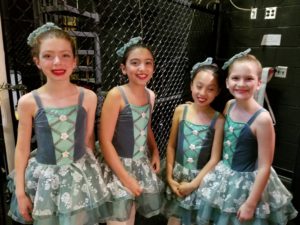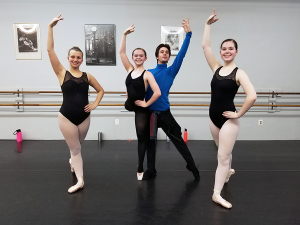Ballet is the foundation for all dance forms and is an integral part of the curriculum at Cuppett PAC. The Center teaches the best of both the Russian (Vaganova) and Italian (Cecchetti) methods. Ballet is required as part of jazz, modern, lyrical, contemporary and character classes and for participation in the Cuppett Dance Company.

Young dancers supporting each other before going on stage.
Ballet Foundations
Ages 3 to 6: Our Creative Dance and Beginning and Advanced Combination classes incorporate basic ballet in their programs. We start with an initial introduction to positions and build to a class which incorporates 30 minutes of Ballet including some barre work.
Ages 7 to 11: Ballet I, II, and III and PreTeen Ballet classes are one hour long. They are structured to teach our young students the basics, building and expanding the skills and techniques for ballet, including the terminology for ballet positions and movements. They will participate in barre exercises as well as movements across the dance floor.
Beginning at the Ballet III level, students participate in the Spring Ballet production with the upper level ballet classes. Students who wish to pursue pointe work or a more serious study of ballet are encouraged to start taking two ballet classes at the Ballet III level in order to help strengthen their muscles and technique for pointe.
Pre-Pointe and Teen Ballet
Ages 11 to 13: Our PrePointe program requires students to take two ballet classes a week – a PrePointe ballet class and a Cecchetti class (a ballet technique class). Students at this level are preparing both strength and technique for pointe work. There are specific requirements that must be met to attain pointe status.
Ages 13+: Cuppett PAC offers three levels of Ballet instruction for these students. For students new to ballet, we offer a Teen Ballet class which introduces the student to the fundamentals. After a year of Teen Ballet, a student will be placed in a ballet class based on their acquired technique and ability.
Pointe Program
For students who desire a more serious study of ballet, after PrePointe they advance to Pointe classes. A student is required to take at least two ballet classes per week to participate at this level. Pointe classes are 1 and 1/2 hours long for Pointe A level and 2 hours for Pointe B and C levels. Cecchetti classes range from one hour to 90 minutes, depending on level. A student may opt to take two Pointe classes if they do not wish to pursue the Cecchetti training. However, most of our students agree that Cecchetti classes noticeably improve their technique and strengthening.

Advanced dancers have the opportunity to partner with our resident ballet master.
Intensive Ballet Program
The most accelerated level of Ballet instruction is our Intensive Ballet Program. Once students reach Pointe “A” level, they may opt to enter the Intensive Ballet A program. At the Intensive “A” level, students are required to take two Intensive Ballet “A” classes per week, each 1 and 1/2 hours long, plus a Cecchetti class. At the Intensive “B” level , students are required to take their appropriate Pointe “B” level class, the Intensive Ballet “B” class, and a Cecchetti class. Students at the Intensive “C” level are required to take a Pointe “C” level class, the Intensive Ballet “C” class, a Cecchetti class, and a Variations class.
Cecchetti Ballet Program
The Cecchetti Method of Ballet, founded by the famous teacher Enrico Cecchetti, is “a balanced and analyzed system of theory and execution for the planned development of the student.” There are children’s Grades I through IV for the beginning levels. Levels V through Diploma are professional: Elementary (Grade V), Intermediate (Grade VI), Advanced (Grade VII), and Diploma. Examiners fly into our area each year to judge students on their practical exam, the results of which are invaluable to a student’s technical improvement. Since Cecchetti is systematic and progressive, students must master the previous material in order to continue through each grade. Everyone is different physically, and many students take longer than one year to master a grade adequately, in order to receive a passing mark.

